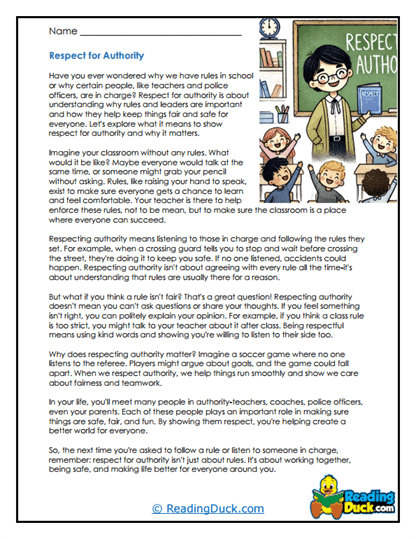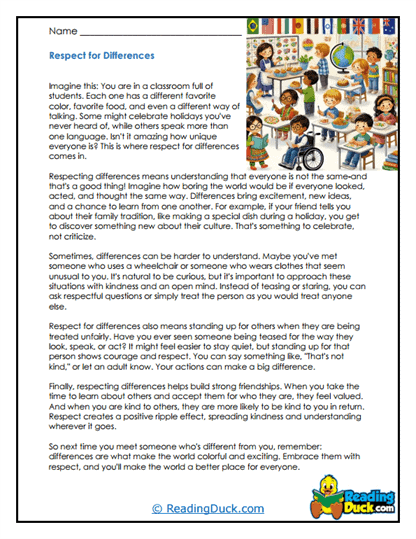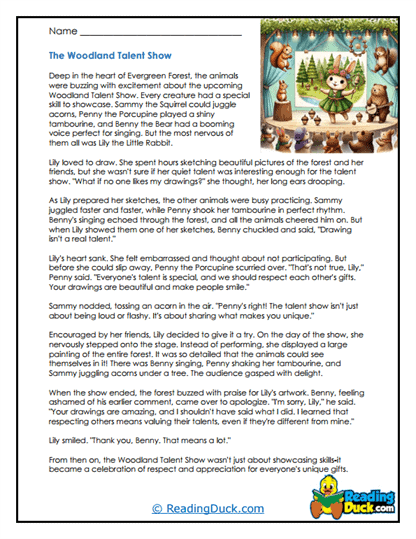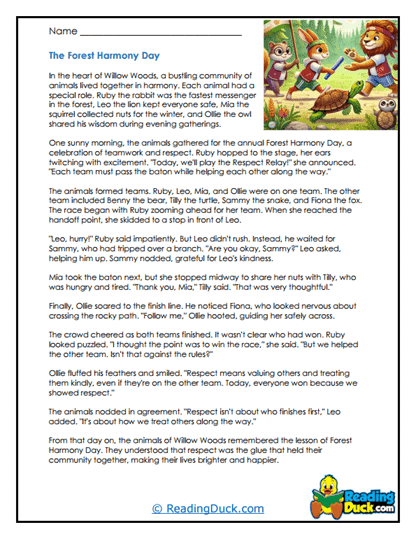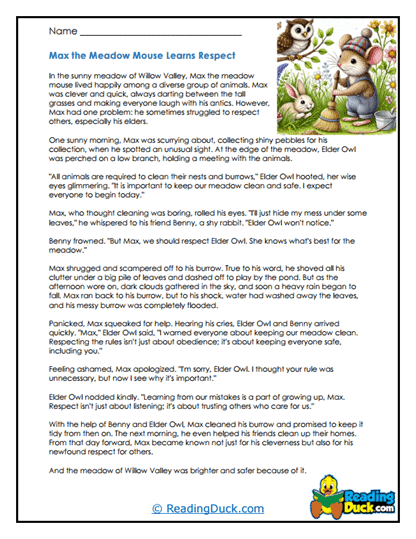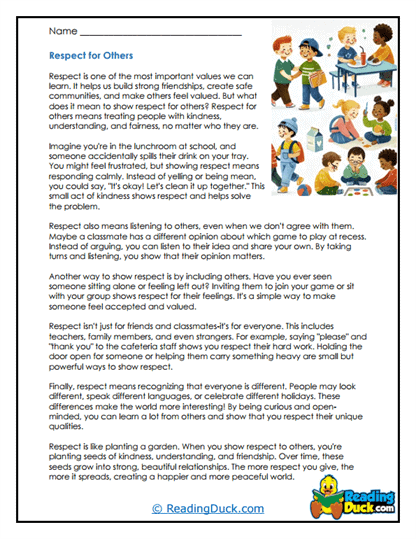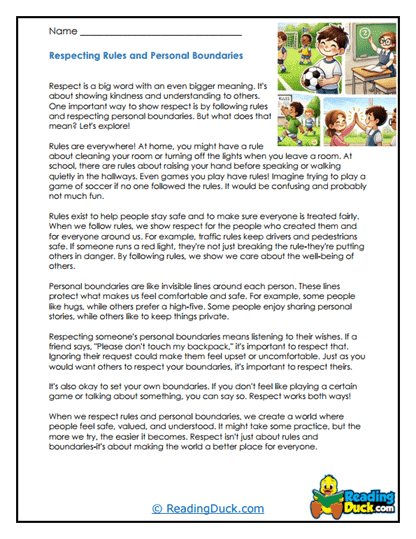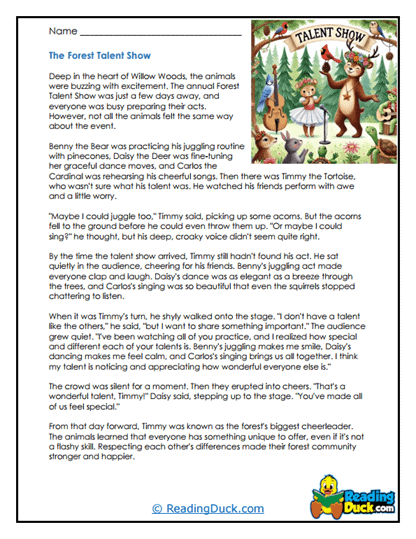Respect Worksheets
About Our Respect Worksheets
Respect is a fundamental value that fosters healthy relationships, personal growth, and community harmony. To help educators introduce this essential concept, Respect Worksheets serve as structured tools that guide students in understanding and applying the principles of respect in their everyday lives. Designed for both traditional classrooms and homeschool settings, these worksheets combine reading comprehension with thought-provoking discussions to engage students in meaningful learning. By using these resources, educators can empower students to reflect on what respect truly mean-for themselves, for others, and for the broader community.
At their core, these types of exercises integrate age-appropriate reading passages with exercises that encourage critical thinking. These passages often depict relatable scenarios where respect, or its absence, plays a central role. For example, a story might explore themes such as standing up for a classmate, treating family members with kindness, or understanding boundaries and personal space. By connecting abstract ideas of respect to concrete examples, these worksheets help students recognize the importance of respectful behavior and its impact on relationships. This approach makes the concept more accessible and relatable, particularly for young learners who are still developing social and emotional skills.
In addition to reading comprehension, the worksheets include a variety of activities to reinforce learning. Multiple-choice questions, open-ended prompts, and creative exercises like drawing or journaling challenge students to analyze the text and express their understanding. Reflection questions prompt students to connect the reading to their own experiences: "Have you ever felt disrespected? How did it make you feel?" or "What are some ways you can show respect to others?" These questions promote empathy and self-awareness, encouraging students to think beyond the worksheet and apply these lessons in real-life situations.
For homeschoolers, these worksheets are particularly valuable as they provide structured, ready-to-use resources that align with character-building goals. Homeschooling parents often seek materials that are both educational and meaningful, and these worksheets meet that need. They can be seamlessly incorporated into language arts or social-emotional learning (SEL) curriculums, serving as stand-alone lessons or as part of a broader theme on character education. The flexibility of Respect Worksheets also allows parents to adapt them to suit their child’s learning style, whether through reading aloud, guided discussions, or independent activities.
Teachers in traditional classrooms will find Respect Worksheets to be an effective tool for fostering a respectful classroom culture. By introducing these resources early in the school year, educators can establish clear expectations for respectful behavior while providing opportunities for ongoing discussion and practice. Group activities and paired discussions built around worksheet exercises can further enhance peer-to-peer learning, as students collaborate to explore the meaning of respect. This not only improves classroom dynamics but also creates a supportive environment where students feel valued and heard.
Through reading passages, reflective questions, and hands-on activities, they encourage students to think deeply about their actions and attitudes toward others. Whether used by teachers in the classroom or homeschool parents, these worksheets help lay the foundation for respectful behavior, fostering empathy, kindness, and self-respect. By integrating these resources into their teaching, educators can inspire students to build stronger relationships and contribute positively to their communities.
Helping Students to Understand the Concept of Respect
Teaching children the concept of respect is essential for their emotional and social development, as it shapes how they interact with others and view themselves. Respect is more than just politeness; it encompasses understanding boundaries, appreciating differences, and showing consideration for others. For students to grasp this multifaceted value, it is important to combine direct instruction, modeling respectful behavior, and providing opportunities for practice. By using a variety of teaching strategies, educators and parents can help children develop a deep, lasting understanding of respect that they carry throughout their lives.
The first step in teaching respect is defining the concept in a way that is age-appropriate and relatable. Children need to understand that respect includes treating others with kindness, listening when someone speaks, and valuing others’ opinions, even when they differ from their own. Educators can introduce these ideas through discussions, stories, and examples that resonate with students. For instance, reading a story where characters demonstrate respect or face challenges because of a lack of it can provide a concrete starting point. Follow-up questions like, "How do you think the character felt when they were disrespected?" or "What could they have done differently?" encourage students to reflect on respectful behavior and its importance.
Modeling respect is equally crucial. Children learn by observing the behavior of adults, so it is essential for teachers, parents, and caregivers to demonstrate respect in their own interactions. This means listening attentively to students, speaking kindly, and treating others with consideration. Adults can also model how to disagree respectfully, showing children that it is possible to handle conflict without resorting to hurtful words or actions. When children see respect in action, they are more likely to internalize it and apply it in their own lives.
To help students understand respect on a deeper level, it is important to provide opportunities for practice. Role-playing activities, group discussions, and collaborative projects allow students to apply what they’ve learned in real-world scenarios. For example, students can practice listening to a partner without interrupting or role-play how to respond respectfully when someone disagrees with them. Teachers can also create classroom guidelines where respect is a shared value, encouraging students to support one another and resolve conflicts respectfully. This practice helps students see how respect can foster stronger relationships and a positive learning environment.
Reinforcing respectful behavior through praise and reflection helps solidify its importance. When students demonstrate respect-such as helping a classmate, sharing, or speaking kindly-acknowledging their actions reinforces positive behavior. Educators and parents can also guide students in reflecting on their own behavior by asking questions like, "How did your words make your friend feel?" or "What happens when we treat each other with respect?" This reflection not only encourages accountability but also helps students understand the emotional impact of respect on themselves and others.
